Analysis of NAB's Dividend Cut: Financial Performance Report
VerifiedAdded on 2023/04/19
|5
|1454
|135
Report
AI Summary
This report analyzes the decision of the National Australia Bank (NAB) to slash its dividend payout in 2019. The memorandum, addressed to the Board of Directors, highlights various management issues contributing to this decision. Key factors include rising costs from the Royal Banking Commission, declining profits, and flattening earnings. The bank's CEO cited the need to strengthen the balance sheet amidst a challenging economic environment. The report details the decline in earnings per share, rising impairment charges due to mortgage delinquencies, and falling housing prices. It also discusses the impact of past financial scandals and the need for accurate cost estimation and strategic revisions. Despite these challenges, NAB's performance remains relatively strong compared to its peers. The report concludes by emphasizing the importance of prudent financial management in navigating current market conditions.
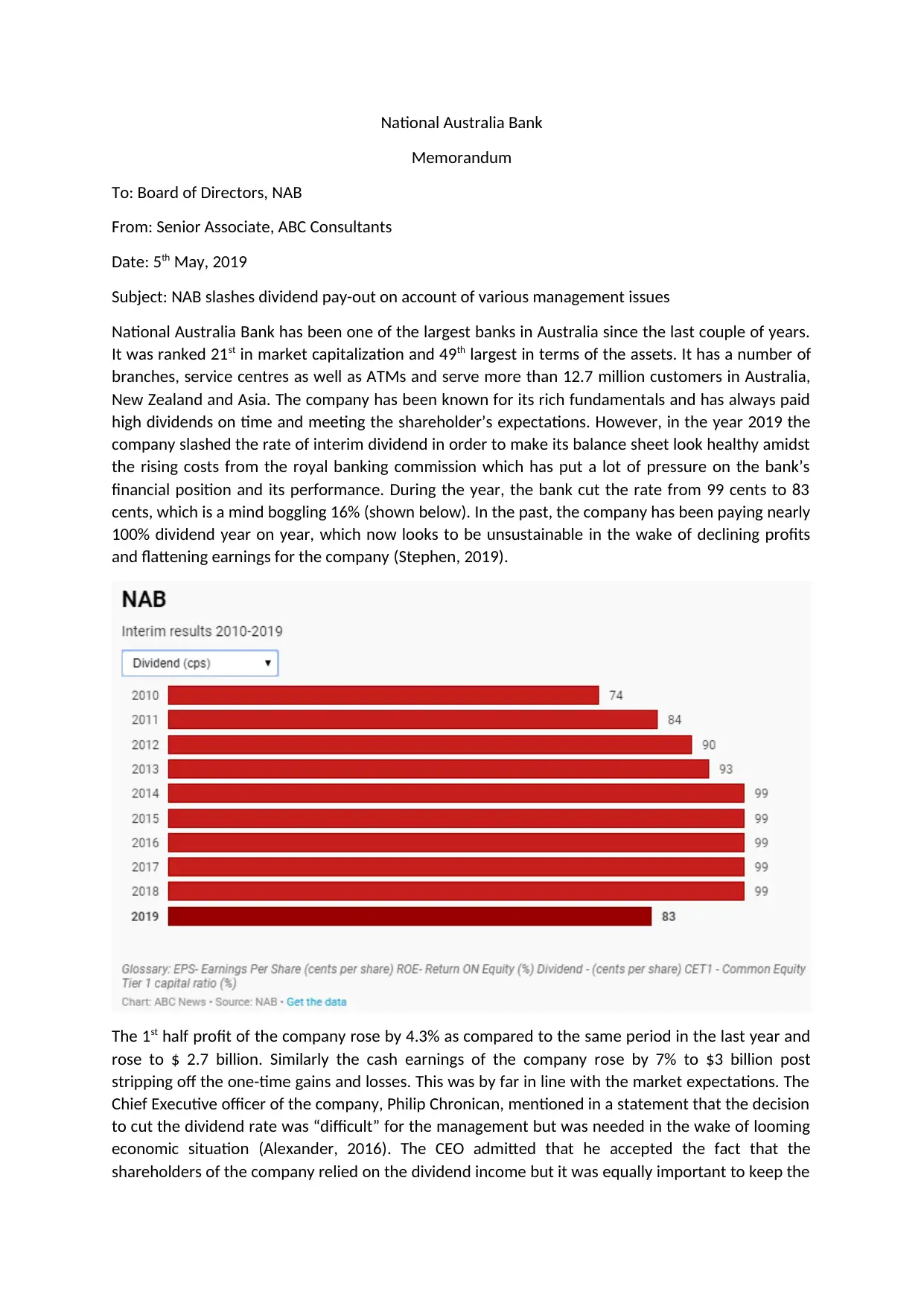
National Australia Bank
Memorandum
To: Board of Directors, NAB
From: Senior Associate, ABC Consultants
Date: 5th May, 2019
Subject: NAB slashes dividend pay-out on account of various management issues
National Australia Bank has been one of the largest banks in Australia since the last couple of years.
It was ranked 21st in market capitalization and 49th largest in terms of the assets. It has a number of
branches, service centres as well as ATMs and serve more than 12.7 million customers in Australia,
New Zealand and Asia. The company has been known for its rich fundamentals and has always paid
high dividends on time and meeting the shareholder’s expectations. However, in the year 2019 the
company slashed the rate of interim dividend in order to make its balance sheet look healthy amidst
the rising costs from the royal banking commission which has put a lot of pressure on the bank’s
financial position and its performance. During the year, the bank cut the rate from 99 cents to 83
cents, which is a mind boggling 16% (shown below). In the past, the company has been paying nearly
100% dividend year on year, which now looks to be unsustainable in the wake of declining profits
and flattening earnings for the company (Stephen, 2019).
The 1st half profit of the company rose by 4.3% as compared to the same period in the last year and
rose to $ 2.7 billion. Similarly the cash earnings of the company rose by 7% to $3 billion post
stripping off the one-time gains and losses. This was by far in line with the market expectations. The
Chief Executive officer of the company, Philip Chronican, mentioned in a statement that the decision
to cut the dividend rate was “difficult” for the management but was needed in the wake of looming
economic situation (Alexander, 2016). The CEO admitted that he accepted the fact that the
shareholders of the company relied on the dividend income but it was equally important to keep the
Memorandum
To: Board of Directors, NAB
From: Senior Associate, ABC Consultants
Date: 5th May, 2019
Subject: NAB slashes dividend pay-out on account of various management issues
National Australia Bank has been one of the largest banks in Australia since the last couple of years.
It was ranked 21st in market capitalization and 49th largest in terms of the assets. It has a number of
branches, service centres as well as ATMs and serve more than 12.7 million customers in Australia,
New Zealand and Asia. The company has been known for its rich fundamentals and has always paid
high dividends on time and meeting the shareholder’s expectations. However, in the year 2019 the
company slashed the rate of interim dividend in order to make its balance sheet look healthy amidst
the rising costs from the royal banking commission which has put a lot of pressure on the bank’s
financial position and its performance. During the year, the bank cut the rate from 99 cents to 83
cents, which is a mind boggling 16% (shown below). In the past, the company has been paying nearly
100% dividend year on year, which now looks to be unsustainable in the wake of declining profits
and flattening earnings for the company (Stephen, 2019).
The 1st half profit of the company rose by 4.3% as compared to the same period in the last year and
rose to $ 2.7 billion. Similarly the cash earnings of the company rose by 7% to $3 billion post
stripping off the one-time gains and losses. This was by far in line with the market expectations. The
Chief Executive officer of the company, Philip Chronican, mentioned in a statement that the decision
to cut the dividend rate was “difficult” for the management but was needed in the wake of looming
economic situation (Alexander, 2016). The CEO admitted that he accepted the fact that the
shareholders of the company relied on the dividend income but it was equally important to keep the
Paraphrase This Document
Need a fresh take? Get an instant paraphrase of this document with our AI Paraphraser
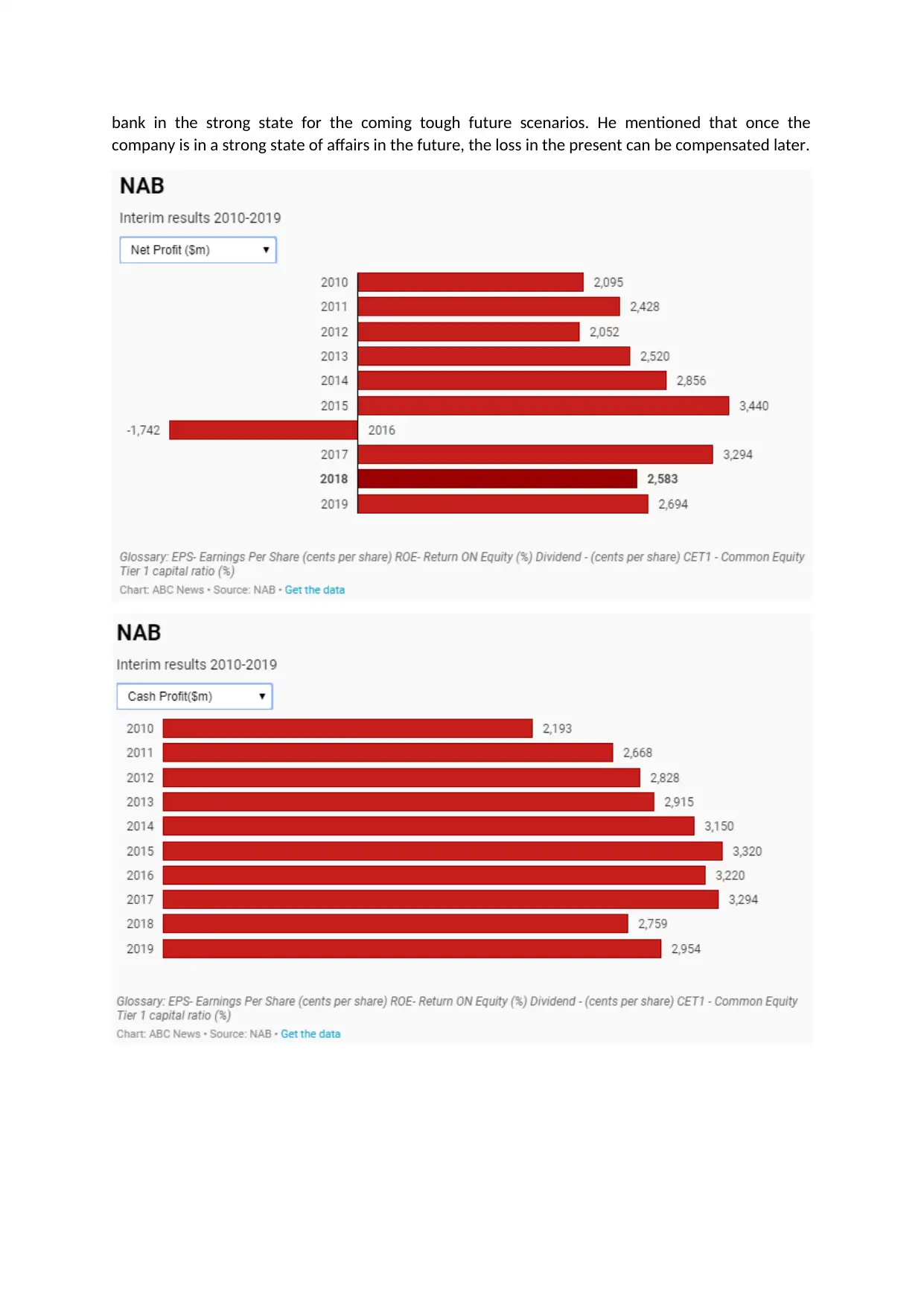
bank in the strong state for the coming tough future scenarios. He mentioned that once the
company is in a strong state of affairs in the future, the loss in the present can be compensated later.
company is in a strong state of affairs in the future, the loss in the present can be compensated later.
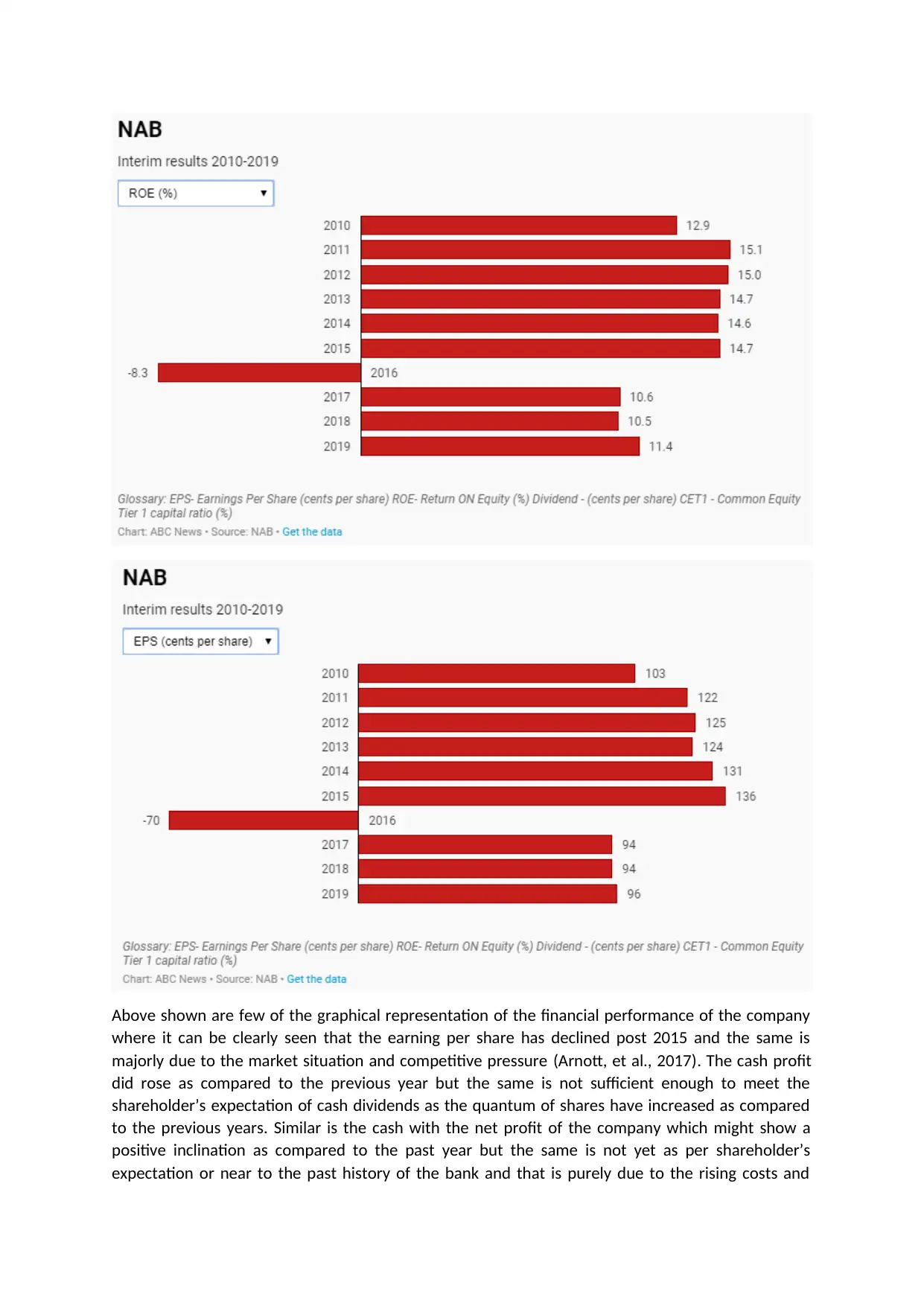
Above shown are few of the graphical representation of the financial performance of the company
where it can be clearly seen that the earning per share has declined post 2015 and the same is
majorly due to the market situation and competitive pressure (Arnott, et al., 2017). The cash profit
did rose as compared to the previous year but the same is not sufficient enough to meet the
shareholder’s expectation of cash dividends as the quantum of shares have increased as compared
to the previous years. Similar is the cash with the net profit of the company which might show a
positive inclination as compared to the past year but the same is not yet as per shareholder’s
expectation or near to the past history of the bank and that is purely due to the rising costs and
where it can be clearly seen that the earning per share has declined post 2015 and the same is
majorly due to the market situation and competitive pressure (Arnott, et al., 2017). The cash profit
did rose as compared to the previous year but the same is not sufficient enough to meet the
shareholder’s expectation of cash dividends as the quantum of shares have increased as compared
to the previous years. Similar is the cash with the net profit of the company which might show a
positive inclination as compared to the past year but the same is not yet as per shareholder’s
expectation or near to the past history of the bank and that is purely due to the rising costs and
⊘ This is a preview!⊘
Do you want full access?
Subscribe today to unlock all pages.

Trusted by 1+ million students worldwide
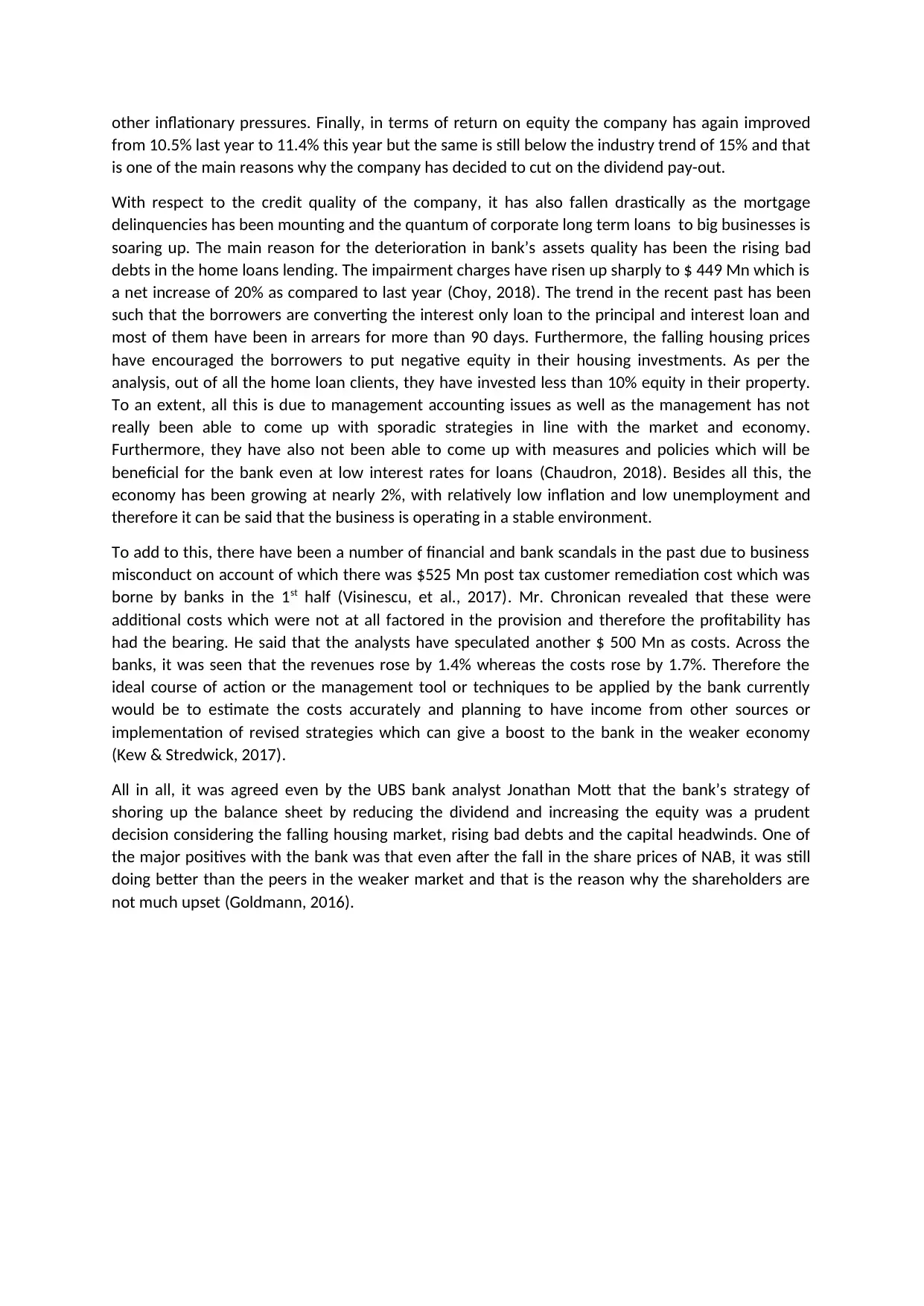
other inflationary pressures. Finally, in terms of return on equity the company has again improved
from 10.5% last year to 11.4% this year but the same is still below the industry trend of 15% and that
is one of the main reasons why the company has decided to cut on the dividend pay-out.
With respect to the credit quality of the company, it has also fallen drastically as the mortgage
delinquencies has been mounting and the quantum of corporate long term loans to big businesses is
soaring up. The main reason for the deterioration in bank’s assets quality has been the rising bad
debts in the home loans lending. The impairment charges have risen up sharply to $ 449 Mn which is
a net increase of 20% as compared to last year (Choy, 2018). The trend in the recent past has been
such that the borrowers are converting the interest only loan to the principal and interest loan and
most of them have been in arrears for more than 90 days. Furthermore, the falling housing prices
have encouraged the borrowers to put negative equity in their housing investments. As per the
analysis, out of all the home loan clients, they have invested less than 10% equity in their property.
To an extent, all this is due to management accounting issues as well as the management has not
really been able to come up with sporadic strategies in line with the market and economy.
Furthermore, they have also not been able to come up with measures and policies which will be
beneficial for the bank even at low interest rates for loans (Chaudron, 2018). Besides all this, the
economy has been growing at nearly 2%, with relatively low inflation and low unemployment and
therefore it can be said that the business is operating in a stable environment.
To add to this, there have been a number of financial and bank scandals in the past due to business
misconduct on account of which there was $525 Mn post tax customer remediation cost which was
borne by banks in the 1st half (Visinescu, et al., 2017). Mr. Chronican revealed that these were
additional costs which were not at all factored in the provision and therefore the profitability has
had the bearing. He said that the analysts have speculated another $ 500 Mn as costs. Across the
banks, it was seen that the revenues rose by 1.4% whereas the costs rose by 1.7%. Therefore the
ideal course of action or the management tool or techniques to be applied by the bank currently
would be to estimate the costs accurately and planning to have income from other sources or
implementation of revised strategies which can give a boost to the bank in the weaker economy
(Kew & Stredwick, 2017).
All in all, it was agreed even by the UBS bank analyst Jonathan Mott that the bank’s strategy of
shoring up the balance sheet by reducing the dividend and increasing the equity was a prudent
decision considering the falling housing market, rising bad debts and the capital headwinds. One of
the major positives with the bank was that even after the fall in the share prices of NAB, it was still
doing better than the peers in the weaker market and that is the reason why the shareholders are
not much upset (Goldmann, 2016).
from 10.5% last year to 11.4% this year but the same is still below the industry trend of 15% and that
is one of the main reasons why the company has decided to cut on the dividend pay-out.
With respect to the credit quality of the company, it has also fallen drastically as the mortgage
delinquencies has been mounting and the quantum of corporate long term loans to big businesses is
soaring up. The main reason for the deterioration in bank’s assets quality has been the rising bad
debts in the home loans lending. The impairment charges have risen up sharply to $ 449 Mn which is
a net increase of 20% as compared to last year (Choy, 2018). The trend in the recent past has been
such that the borrowers are converting the interest only loan to the principal and interest loan and
most of them have been in arrears for more than 90 days. Furthermore, the falling housing prices
have encouraged the borrowers to put negative equity in their housing investments. As per the
analysis, out of all the home loan clients, they have invested less than 10% equity in their property.
To an extent, all this is due to management accounting issues as well as the management has not
really been able to come up with sporadic strategies in line with the market and economy.
Furthermore, they have also not been able to come up with measures and policies which will be
beneficial for the bank even at low interest rates for loans (Chaudron, 2018). Besides all this, the
economy has been growing at nearly 2%, with relatively low inflation and low unemployment and
therefore it can be said that the business is operating in a stable environment.
To add to this, there have been a number of financial and bank scandals in the past due to business
misconduct on account of which there was $525 Mn post tax customer remediation cost which was
borne by banks in the 1st half (Visinescu, et al., 2017). Mr. Chronican revealed that these were
additional costs which were not at all factored in the provision and therefore the profitability has
had the bearing. He said that the analysts have speculated another $ 500 Mn as costs. Across the
banks, it was seen that the revenues rose by 1.4% whereas the costs rose by 1.7%. Therefore the
ideal course of action or the management tool or techniques to be applied by the bank currently
would be to estimate the costs accurately and planning to have income from other sources or
implementation of revised strategies which can give a boost to the bank in the weaker economy
(Kew & Stredwick, 2017).
All in all, it was agreed even by the UBS bank analyst Jonathan Mott that the bank’s strategy of
shoring up the balance sheet by reducing the dividend and increasing the equity was a prudent
decision considering the falling housing market, rising bad debts and the capital headwinds. One of
the major positives with the bank was that even after the fall in the share prices of NAB, it was still
doing better than the peers in the weaker market and that is the reason why the shareholders are
not much upset (Goldmann, 2016).
Paraphrase This Document
Need a fresh take? Get an instant paraphrase of this document with our AI Paraphraser
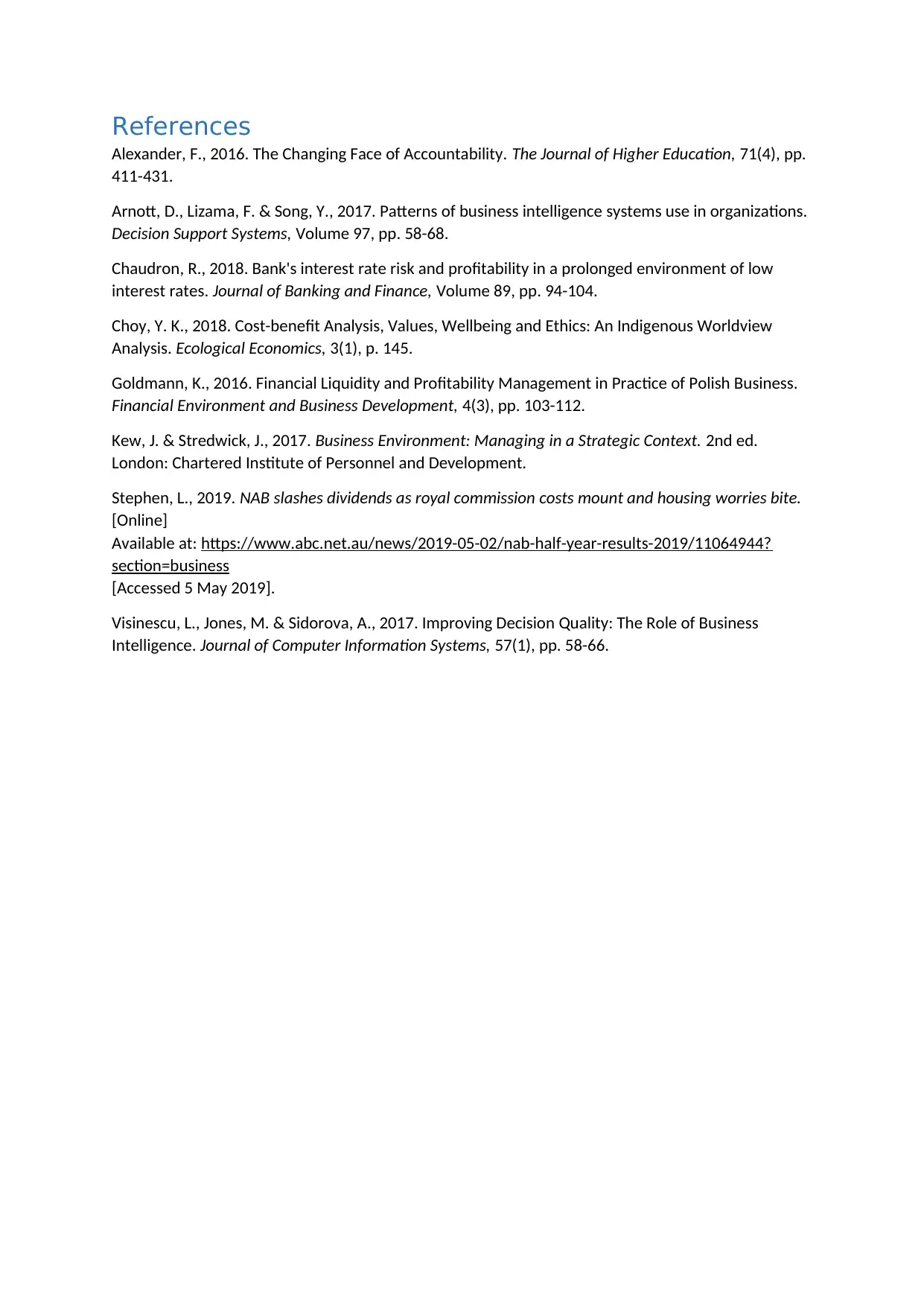
References
Alexander, F., 2016. The Changing Face of Accountability. The Journal of Higher Education, 71(4), pp.
411-431.
Arnott, D., Lizama, F. & Song, Y., 2017. Patterns of business intelligence systems use in organizations.
Decision Support Systems, Volume 97, pp. 58-68.
Chaudron, R., 2018. Bank's interest rate risk and profitability in a prolonged environment of low
interest rates. Journal of Banking and Finance, Volume 89, pp. 94-104.
Choy, Y. K., 2018. Cost-benefit Analysis, Values, Wellbeing and Ethics: An Indigenous Worldview
Analysis. Ecological Economics, 3(1), p. 145.
Goldmann, K., 2016. Financial Liquidity and Profitability Management in Practice of Polish Business.
Financial Environment and Business Development, 4(3), pp. 103-112.
Kew, J. & Stredwick, J., 2017. Business Environment: Managing in a Strategic Context. 2nd ed.
London: Chartered Institute of Personnel and Development.
Stephen, L., 2019. NAB slashes dividends as royal commission costs mount and housing worries bite.
[Online]
Available at: https://www.abc.net.au/news/2019-05-02/nab-half-year-results-2019/11064944?
section=business
[Accessed 5 May 2019].
Visinescu, L., Jones, M. & Sidorova, A., 2017. Improving Decision Quality: The Role of Business
Intelligence. Journal of Computer Information Systems, 57(1), pp. 58-66.
Alexander, F., 2016. The Changing Face of Accountability. The Journal of Higher Education, 71(4), pp.
411-431.
Arnott, D., Lizama, F. & Song, Y., 2017. Patterns of business intelligence systems use in organizations.
Decision Support Systems, Volume 97, pp. 58-68.
Chaudron, R., 2018. Bank's interest rate risk and profitability in a prolonged environment of low
interest rates. Journal of Banking and Finance, Volume 89, pp. 94-104.
Choy, Y. K., 2018. Cost-benefit Analysis, Values, Wellbeing and Ethics: An Indigenous Worldview
Analysis. Ecological Economics, 3(1), p. 145.
Goldmann, K., 2016. Financial Liquidity and Profitability Management in Practice of Polish Business.
Financial Environment and Business Development, 4(3), pp. 103-112.
Kew, J. & Stredwick, J., 2017. Business Environment: Managing in a Strategic Context. 2nd ed.
London: Chartered Institute of Personnel and Development.
Stephen, L., 2019. NAB slashes dividends as royal commission costs mount and housing worries bite.
[Online]
Available at: https://www.abc.net.au/news/2019-05-02/nab-half-year-results-2019/11064944?
section=business
[Accessed 5 May 2019].
Visinescu, L., Jones, M. & Sidorova, A., 2017. Improving Decision Quality: The Role of Business
Intelligence. Journal of Computer Information Systems, 57(1), pp. 58-66.
1 out of 5
Related Documents
Your All-in-One AI-Powered Toolkit for Academic Success.
+13062052269
info@desklib.com
Available 24*7 on WhatsApp / Email
![[object Object]](/_next/static/media/star-bottom.7253800d.svg)
Unlock your academic potential
Copyright © 2020–2025 A2Z Services. All Rights Reserved. Developed and managed by ZUCOL.





